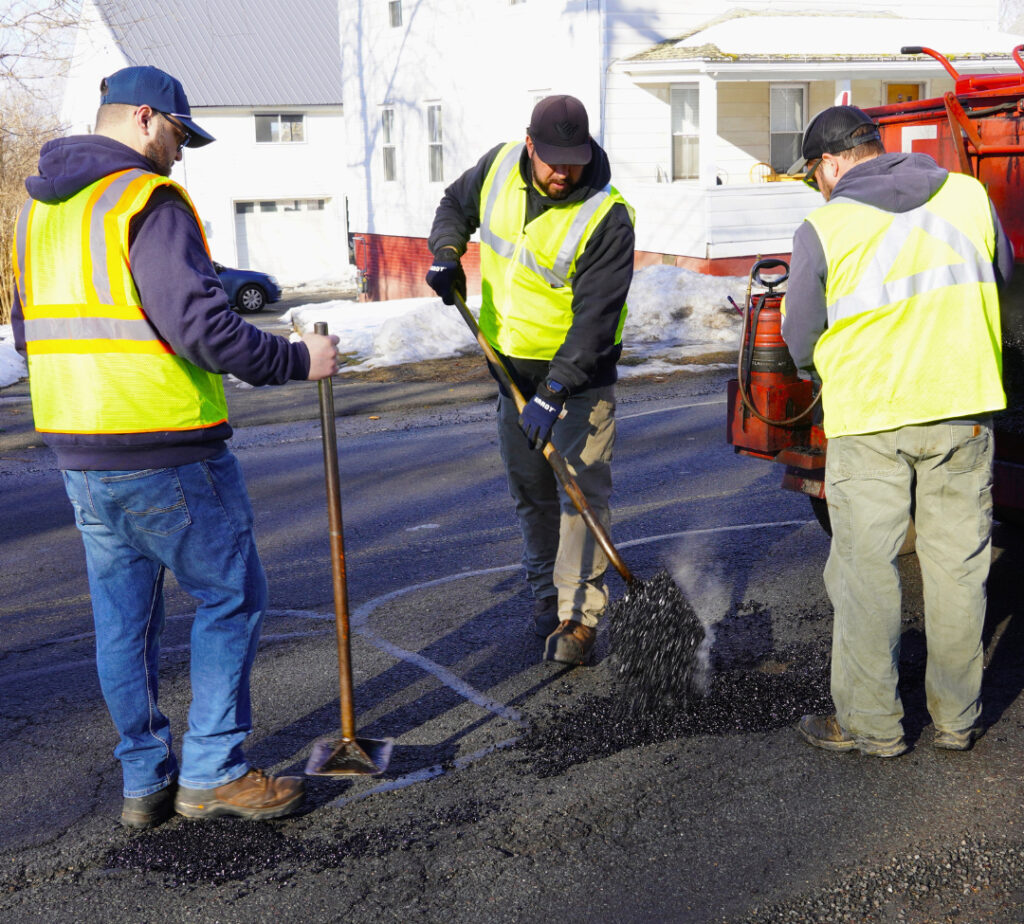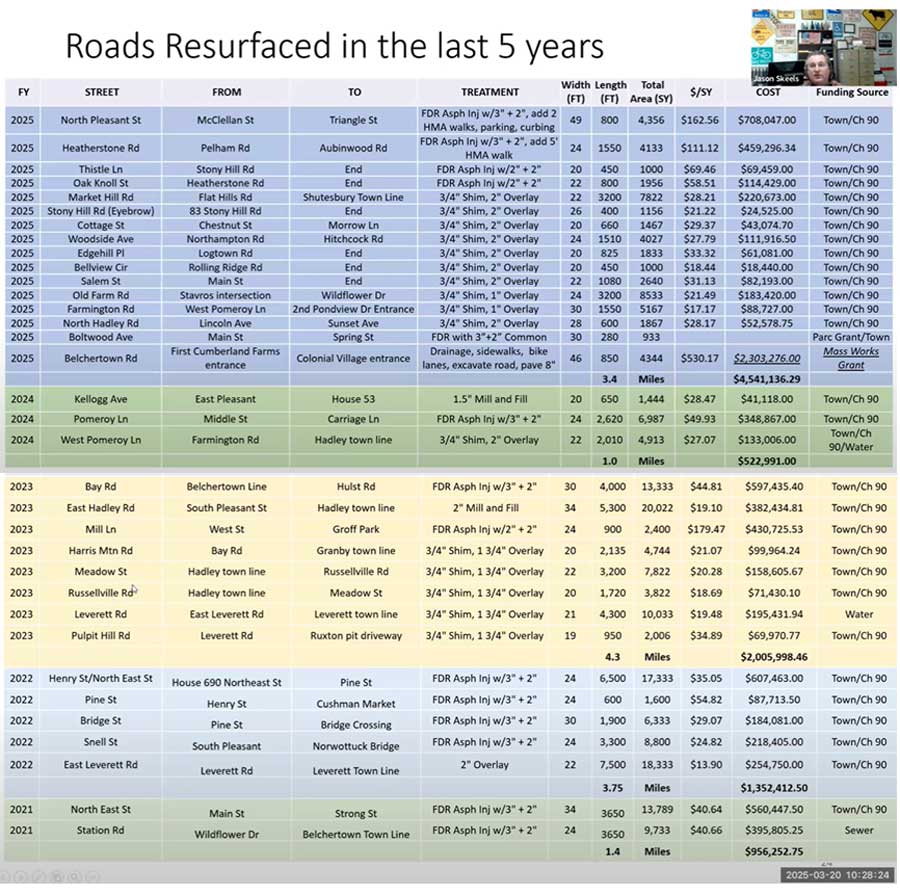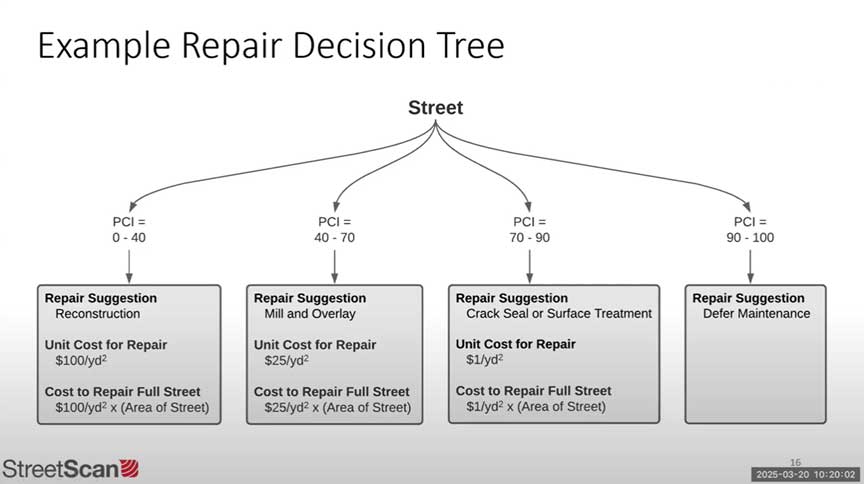Amherst Ranks Last in Massachusetts in Public Works Spending Per Capita

A crew from the Amherst Department of Public Works filling potholes on Sunderland Road, Febuary 2025. (L-R) Scott Gavron, Robert Zakaitis, and DJ Gancorz. Photo: amherstma.gov
In 2024 Amherst spent just under $2 million from its general fund on public works according to state data. When divided by a population of 39,263, this works out to an investment of local tax revenues into highways and other infrastructure of $49.75 per resident.
This level of expenditure places Amherst in last place among all Massachusetts cities and towns. The statewide average public works spending per person is $367 or more than seven times higher than what Amherst allocated from its general fund.
See related: Little Relief in Sight for Amherst’s Roads
Amherst’s low budget priority for public works helps explain why the town invested only $522,991 in road resurfacing in 2024 and completed only 1 mile of road treatment.

Road maintenance is typically paid for by a combination of general fund appropriations and state Chapter 90/Fair Share funding that added $1.2 million in 2024. Town Engineer Jason Skeels explained that in 2024 “we were working on the Pomeroy roundabout and were worried about the budget so we only did a couple of roads and saved some of our chapter 90 money just in case we had to spend it to finish the roundabout.”
In FY25 Amherst road resurfacing coverage improved to 4.3 miles thanks to a MassWorks grant of $2.3 million for work on Belchertown Rd. Using the town’s StreetScan program, Skeels estimates that to maintain the town’s current Pavement Condition Index of 62 (55 to 70 is considered “fair”) will require a resurfacing commitment of $18 million over the next five years, or $3.6 million per year. Actual improvement of road conditions will require spending $5 million per year.
Amherst Library Spending Exceeds Public Works
Other categories of general fund spending have fared better in Amherst, e.g. library funding. The Jones Library is a cherished institution in town, benefiting from a dedicated Friends organization and a strong library lobby.
The town contributed $2,213,530 from its general fund in 2024 toward the Jones Library operating budget for a rate of $55.26 per resident. This makes Amherst one of only two towns in the commonwealth to spend more for library services than for public works. The other is West Tisbury on the island of Martha’s Vineyard with a total of 14 miles of roads.
Beginning in FY27 the commitment of town funds toward the Jones Library will see a bump, as the Capital Improvement Program calls for paying back debt service of $1.3 million for the library renovation-expansion project. This amounts to an additional general fund expense of approximately $34 per resident.
What’s a Citizen to Do?
A robust submission of comments to the Amherst Indy indicates a high level of concern among residents over the state of Amherst roads, and offers several suggestions.
The idea that the University of Massachusetts should contribute toward improving Amherst’s roads makes sense. UMass accounts for more than half of the town’s population and is responsible for a corresponding amount of wear and tear on the town’s roads. The state’s formula for apportioning Chapter 90 road funds is in fact based on each community’s population and employment as well as road miles. This works to Amherst’s benefit as in 2024 the town received $11,500 per mile in state road funding compared to the statewide average of $9,000 per mile. However, as is the case with Chapter 70 public education support, state funding for roads does not come close to providing what Amherst needs.
Questioning the materials and techniques used to address road repairs is also in order. Surface treatment is no substitute for milling/overlay which is no substitute for road reconstruction. More durable repairs are more expensive.

The ultimate solution is to elect leaders who understand sound fiscal management and recognize the importance of public works. The campaign season for the November election of a new town council is gearing up. Know where candidates stand on road maintenance or consider taking out nomination papers!
See related: Nomination Papers Available for the 2025 Amherst Town Election

The condition of Amherst’s roads is a scandal. I have complained to the town manager, the director of public works, and through the online pothole reporting portal, to little avail. I live on North Prospect St., which is accessed on Hallock St. Both streets are in very poor repair, and Hallock St. is outright dangerous. Most people focus on the damage to car suspension systems, but I am an avid cyclist, riding my bike for pleasure and to run errands. Some of the potholes on Hallock St. could easily swallow a standard bicycle wheel, and they wreak havoc on the smaller wheels on my folding bike.
In response to’ complaints from me and other residents, a crew came out and patched only some of the holes. Why not all of them? Did they run out of material? Was it break time? The work performed is sloppy and will not last long. Those patches will come off even before the first snow plow comes along to dig them up again.
And don’t get me started on all the gratuitous snow plowing Amherst does: It takes just a few snowflakes to bring out the plows that continually and reliably tear up the streets.
I don’t know a single resident of Amherst who hasn’t complained about the condition of our roads—and many of our sidewalks (that make them noncompliant with ADA regulations). Visitors come, raise their eyebrows, and wonder about their poor condition. It doesn’t make sense that a town with one of the highest tax rates in the state spends so little on public works. Let’s get our priorities straight.
It isn’t only the lack of appropriation of $ for road/sidewalk repair and maintenance—- it is also the totally inadequate quick fixes that are a waste of time and money. An example are the 4 deep potholes between Clarke House and Switzer Park. The stuff they threw into them to prevent falls by the many elderly people who live in Clarke House and the families who use the park is now GONE. Cheep fixes don’t last. Let’s have our DPW have the funds to do the jobs right the first time.
Focussing on a library rather than the infrastructure seems to be tipping towards desires of the elite rather than the needs of the majority. Going hand in hand with West Tisbury says nothing good about the political choices made in Amherst. VOTE
It seems pretty clear that UMass should be paying significantly more money to Amherst in order for the town infrastructure to properly support its student body. That’s not a problem the town can solve itself – it must be solved at the state level. And good luck getting more money out of them to support anything in western Massachusetts.
I agree with the people here who comment on the poor workmanship of pothole repair in our town. When I drive over these repaired areas I find that the road is still almost as bumpy to drive on as the potholes. I recently was driving on Warren Wright road in belchertown and noticed that the potholes were repaired so beautifully that you could barely notice you were driving over a repaired area. Why can’t Amherst take the time and effort to fix potholes the right way like Belchertown does at least as it was done on Warren Wright road.